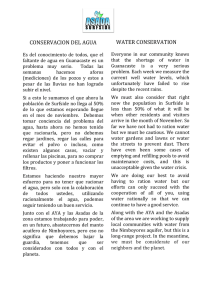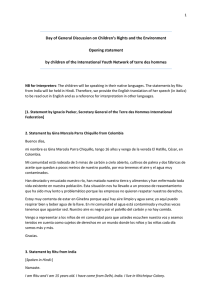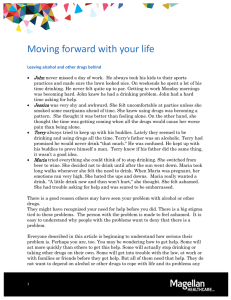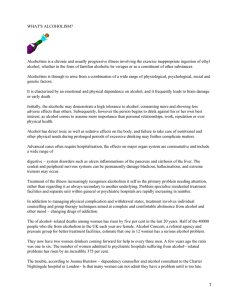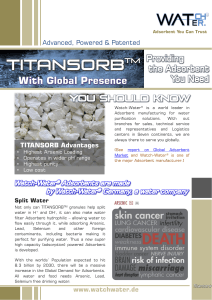What should I do? What happened? What was done? Secondary
Anuncio
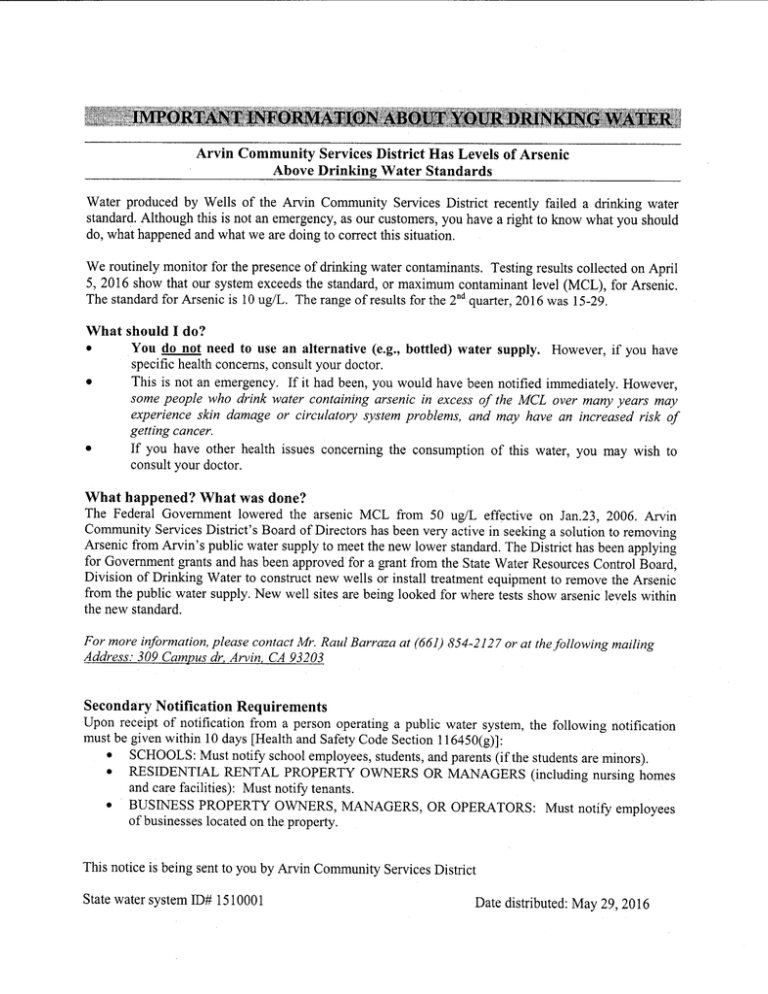
Arvin Community Services District Has Levels of Arsenic Above Drinking Water Standards Water produced by Wells of the Arvin Community Services District recently failed a drinking water standard. Although this is not an emergency, as our customers, you have a right to know what you should do, what happened and what we are doing to correct this situation. We routinely monitor for the presence of drinking water contaminants. Testing results collected on April 5, 2016 show that our system exceeds the standard, or maximum contaminant level (MCL), for Arsenic. The standard for Arsenic is 10 ug/L. The range of results for the 2nd quarter, 2016 was 15-29. What should I do? • • • You do not need to use an alternative (e.g., bottled) water supply. However, if you have specific health concerns, consult your doctor. This is not an emergency. If it had been, you would have been notified immediately. However, some people who drink water containing arsenic in excess of the MCL over many years may experience skin damage or circulatory system problems, and may have an increased risk of getting cancer. If you have other health issues concerning the consumption of this water, you may wish to consult your doctor. What happened? What was done? The Federal Government lowered the arsenic MCL from 50 ugiL effective on Jan.23, 2006. Arvin Community Services District's Board of Directors has been very active in seeking a solution to removing Arsenic from Arvin's public water supply to meet the new lower standard. The District has been applying for Government grants and has been approved for a grant from the State Water Resources Control Board, Division of Drinking Water to construct new wells or install treatment equipment to remove the Arsenic from the public water supply. New well sites are being looked for where tests show arsenic levels within the new standard. For more information,please contact Mr. Raul Barraza at (661) 854-2127 or at thefollowing mailing Address: 309 Campus dr. Arvin. CA 93203 Secondary Notification Requirements Upon receipt of notification from a person operating a public water system, the following notification must be given within 10 days [Health and Safety Code Section 116450(g)]: • SCHOOLS: Must notify school employees, students, and parents (if the students are minors). • RESIDENTIAL RENTAL PROPERTY OWNERS OR MANAGERS (including nursing homes and care facilities): Must notify tenants. • BUSINESS PROPERTY OWNERS, MANAGERS, OR OPERATORS: Must notify employees of businesses located on the property. This notice is being sent to you by Arvin Community Services District State water system ID# 1510001 Date distributed: May 29, 2016 INFORMACION IMPORTANTE SOBRE SU AGUA DE BEBER Distrito Comunitario de Servicios de Arvin (Arvin Community Services District) Tiene niveles de Arsenico sobre el estandar normal en su agua potable. Agua producida de los posos de nuestro sistema de agua recientemente fallaron de 10 normal. Aunque esto no es una emergencia ustedes como nuestros clientes tienen el derecho de estar informados, saber que hacer, de que paso y de que estamos haciendo para corregir esta situaci6n. Nosotros rutinariamente monitoreamos la presencia de contaminantes en el agua. Muestras de agua colectadas en 4/5/2016 para las norias (posos) 1,5,6,9, 10 y 11 mostraron que nuestro sistema excede el estandar 0 el nivel de contaminante maximo (MCL) de Arsenico, El estandar de Arsenico es de 10 ugiL. La variedad de resultados de arsenico para el segundo trimestre de 2016 fue 15 a 29 ug/L. ;,Que debemos hacer? • Usted ill!necesita otra alternativa de agua (por ejemplo: agua embotellada). Si usted tiene una inquietud especifica sobre su salud, consulte a su medico. • Esto no es una emergencia. De ser asi usted fuera sido notificado inmediatamente. Sin embargo algunas personas que beben agua con Arsenico en exceso de MCL durante muchos afios pueden experimentar dafios en la piel 0 problemas circulatorios, pueden tambien aumentar los riesgos de contraer cancer. • Si usted tiene mas preguntas de salud concieme el consumo de esta agua consulte a su medico. ;,Que paso? Y ;,Que se hizo? El gobierno federal bajo este estandar de Arsenico de MCL 50 ug/L a 10ug/L (partes por bill6n) efecto en Enero 23, 2006. El Distrito Comunitario de Servicios de Arvin (Arvin Community Services District) ha estado muy activo en encontrar la soluci6n para remover el Arsenico del agua publica de Arvin, para asi alcanzar un nivel mas bajo de 10 estandar. El Distrito ha estado buscando soluciones para llegar a los niveles estandar. El Distrito tambien ha aplicado para prestamos y bonos del Departamento de State Water Resources Control Board y ha sido aceptado para construir nuevos pozos de agua 0 instalar equipos de tratamiento para remover el Arsenico del agua publica. Nuevas locaciones han sido vistas para futuros posos, donde el nivel de Arsenico se encuentre en los estandares nuevos. Para mas informacion contactar a Raul Barraza al (661) 854-2127 93203 0 a la direccion 309 Campus Dr., Arvin, CA Por Favor comparta esta informacion con todas las personas quien bebe esta agua, especialmente con aquellas que no reciban esta noticia directamente. (Por ejemplo: personas que vivan en apartamentos, asilos, escuelas, y negocios.) Usted puede hacer esto poniendo esta noticia en lugares publicos 0 distribuyendocopias 0 por correo. Requerimientos Secundarios de Notificaci6n Despues que reciban esta notificacion de las personas que operan el sistema de agua publica, La siguiente notificacion tendra que ser dada en los siguientes 10 dias. [C6digo de Salud y seguridad Seccion 116450(g)]: • ESCUELAS: deben notificar a sus empleados, estudiantes, y a los padres de familia (si los estudiantes son menores de edad). • PROPIETARIOS DE APARTAMENTOS 0 CASAS DE RENTA 0 MANEJADORES (incluyendo asilos y facilidades de cuidados) deben notificar a los tenientes. PROPIET ARIOS DE NEGOCIOS, MANEJADORES, U OPERADORES: Deben notificar a sus empleados de los negocios localizados en la propiedad. Esta noticia fue enviada a usted por Arvin Community Services District State Water System ID#: 1510001. Fecha distribuida: Mayo 29, 2016 RVIN COMMUNITY SERV CES DISTRICT 309 CAMPUS DR.· ARVIN. CAL..IFO NIA 93203 Phone (.661) 854.2127 • Fax (661) 854-8230 2015 Water Quality Report .. This brochure explains the quality of drinking water provided by/the Arvin Community Services District. Included is a listing of results from water quality tests as an explanation of where our water comes from and tips on how to interpret the data. We're proud to share our results with you. Please read them carefully. Este informe contiene informacion muy importante sobre su agua potable. Traduzcalo 0 hable con alguien que 10 entienda bien. Copias en espaiiol de este reporte de calidad de agua estan disponibles llamando aI661-854-2127. We're very pleased to provide you with this year's Water Quality Report. We want to keep you informed about the excellent water and services we have delivered to you over the past year. Our goal is and always has been, to provide to you the safest and most dependable supply of drinking water possible. Our water source in 2015 was from groundwater from six active water wells, normally 300 to 900 feet deep, well's # 1, 5, 6, 8, 10 and 11. The location of all our water wells are: * Well #1 - 847 South Derby St. at the Maintenance Facility - used in 2015 * Well #5 - 5th Street near North Derby Street - used in 2015 * Well #6 - Monroe Street near Durham St. - used in 2015 * Well #8 - on Charles Street - put in service in 1998 - used in 2015 * Well #9 - on Meyer Street near Orange Street - put in service in 1999 - not used in 2015 * Well # 10 - on Blue Loop Lane - put in service in 2009 - used in 2015 * Well #11 - 3301 Meyer St -put in service in 2013 - used in 2015 QUESTIONS If you have any questions about this report or concerning your water utility, please contact Raul Barraza with Arvin Community Services District at 661-854-2127. We want our valued customers to be informed about their water utility. If you want to learn more, please attend any of our regularly scheduled meetings. They are held on the first and third Monday of each month at 6:00 P.M., at the District office at 309 Campus Drive, Arvin, California. We encourage public interest and participation in our community's decisions affecting drinking water and any other issues. Arvin Community Services District routinely monitors for contaminants in your drinking water according to Federal and State laws. This table shows the results of our monitoring for the period of January 1st to December 31st 2015. For those regulated contaminates the system is allowed to monitor for less often than once a year, the most recent testing done in accordance with the regulations has been used. We are required to monitor your drinking water for specific contaminants on a regular basis. Results of regular monitoring are an indicator of whether or not our drinking water meets health standards. How to Read This Table In order to ensure that tap water is safe to drink, the U.S. Environmental Protection Agency (USEPA) and the State Water Resources Control Board, Division of Drinking Water (Division) prescribe regulations that limit the amount of certain contaminants in water provided by public water systems. Division regulations also establish limits for contaminants in bottled water that provide the same protection for public hetlth. The results of tests performed in 2015 or the most recent testing ava\able are presented in the table. In addition to the constituents listed in the report, we have conducted monitoring on all active wells for additional organic chemicals for which the State Water Resources Control Board, Division of Drinking Water (Division) and USEPA have not yet set a standard, and all results were below detection levels unless otherwise noted. For additional water quality data, contact Raul Barraza at 661-854-2127. Terms used in the Water Quality Table and in other parts of this report are defined here. Maximum Contaminant Level or MCL: The highest level of a contaminant tJIat is allowed in drinking water. Primary MCLs are set as close to the PHGs (or MCLGs) as is economically and tecbnologifally feasible. Secondary MCLs are set to protect the odor, taste, and appearance of drinking water. Maximum Contaminant Level Goal or MCLG: The level of a contaminant in drinking water below which there is no known or expected risk to health. MCLGs are set by the U.S. Environmental Protection Agency. Public Health Goal or PHG: The level of a contaminant in drinking water below which there is no known expected risk to health. PHGs are set by the California Environmental Protection Agency. Primary Drinking Water Standard or PDWS: MCLs for contaminants that affect health along with their monitoring and reporting requirements, and water treatment requirements. Secondary Drinking Water Standard or SDWS: MCLs for contaminants that affect taste, odor; or appearance of the drinking water. Contaminants with SDWSs do not affect the health at the MCL levels. Range: The lowest to the highest values for all samples tested for each contaminant. If only one sample is tested, or no range is required for this report, then no range is listed for that contaminant in the table. Key To Table AL = Action Level PHG = Public Health goal NL = Notification Level ND = None Detected MRDL = Maximum Residual Detection Level MCL=Maximum Contaminant Level MRSDLG = Maximum Residual Detection Level Goal ppm = parts per million, SMCL = Secondary Maximum Contaminant Level or milligrams per liter (mg/L) MCLG = Maximum Contaminant Level Goal ppb = parts per billion, NTU = Nephelometric Turbidity Units or micrograms per liter (ug/L) pCi/L = Picocuries per Liter (a measure of radioactivity) nla = not applicable ppt = parts per trillion Summary Information for Contaminants Exceeding an MCL, MRDL, AL or Violation of Any TT or Monitoring and Reporting Requirements. Arsenic • Some people who drink water containing arsenic in excess of the MCL over many years could experience skin damage or problems with their circulatory system, and may have an increased risk of getting cancer. The Federal government lowered the arsenic MCL from 50ug/L to 10ug/L effective on Jan. 23, 2006. Arvin Community Services District's Board of Directors has been very active in seeking a solution to removing arsenic from Arvin's public water supply to meet the new lower water standard. The District has been researching solutions to meet the new arsenic standard. The District has been applying for government grants and has been approved for a grant from the State Water Resources Control Board to construct 2 new replacement wells in 2016 and also looking to obtain funds for 3 more replacement wells. - - - - ---------------------------------------------------------------------- Additional General Information on Drinking Water • All Drinking water, including bottled water, may reasonably be expected to contain at least small amounts of contaminants, not necessarily indicate that water poses a health risk. More information about contaminants and potential health effects can be obtained by calling the USEPA's Safe Drinking Water Hotline (1-800-426-4791). The sources of drinking water (both tap water and bottled water) in~ude rivers, lakes, streams, ponds, reservoirs, springs, and wells. As water travels over the surface of the land Jt. through the ground, it dissolves naturallyoccurring minerals and, in some cases, radioactive material, and can pick up substances resulting from the presence of animals or from human activity. • Contaminants that may be present in source water include: _(A) Microbial contaminants, such as viruses and bacteria that may come from sewage treatment plants, septic systems, agricultural livestock operations, and wildlife. ... (B) Inorganic contaminants, such as salts and metals, that can be 11aturally-occurring or result from urban storm water runoff, industrial or domestic wastewater discharges, oil and gas production, mining, or farming. (C) Pesticides and herbicides, that may come from a variety of sources such as agriculture, urban storm water runoff, and residential uses. (D) Organic chemical contaminants, including synthetic and volatile organic chemicals that are by-products of industrial processes and petroleum production, and can also come from gas stations, urban storm water runoff, agricultural application, and septic systems. (E) Radioactive contaminants that can be naturally-occurring or be the result of oil and gas production and mining activities. • Some people may be more vulnerable to contaminants in drinking water than the general population. Immunocompromised persons such as persons with cancer undergoing chemotherapy, persons who have undergone organ transplants, people with HIV/AIDS or other immune system disorders, some elderly, and infants can be particularly at risk from infections. These people should seek advice about drinking water from their health care providers. USEPNCenters for Disease Control (CDC) guidelines on appropriate means to lessen the risk of infection by Cryptosporidium and other microbial contaminants are available from the Safe Drinking Water Hotline (1-800-426-4791). • The average nitrate level was 13.83 ppm with a maximum level of 42 ppm. Nitrate in drinking water at levels above 45 ppm is a health risk for infants of less than six months of age. Such nitrate levels in drinking water can interfere with the capacity of the infant's blood to carry oxygen, resulting in serious illness; symptoms include shortness of breath and blueness of the skin. Nitrate levels above 45 ppm may also affect the ability of the blood to carry oxygen in other individuals, such as pregnant women and those with specific enzyme deficiencies. If you are caring for an infant, or you are pregnant, you should ask advice from your health care provider. • If present, elevated levels of lead can cause serious health problems, especially for pregnant woman and young children. Lead in drinking water is a primary from materials and components associated with service lines and home plumbing. Arvin Community Services District is responsible for providing the highest possible quality drinking water, but cannot control the variety of materials used in plumbing components. When your water has been sitting for several hours, you can minimize the potential for lead exposure by flushing your tap for 30 seconds to 2 minutes before using water for drinking or cooking. If you are concerned about lead in your water, you may wish to have your water tested. Information on lead in drinking water, testing methods, and steps you can take to rmmrruze exposure is available from the Safe Drinking Water Hotline or at http://www.epa.gov/safewater/lead. Nitrates Lead Source Water Assessment A source water assessment was conducted for the water supply wells of the Arvin Community Services District water system in May 2002. The sources are considered most vulnerable to the following activities associated with contaminants detected in the water supply: Fertilizer, PesticidelHerbicide application, Septic Systems, Auto-repair shops, Wells- Oil, Gas, Geothermal The source is considered most vulnerable to the following activities not associated with any detected contaminants: Known Contaminant Plumes- Metal Plating/Finishing/Fabricating, Underground Tanks- Confirmed Leaking Table 1: Detection of Contaminants with Primary Drinking Water Standard Year Tested Units PHG (MCLG) MCL Average Range Arsenic*' 2015 ppm 0.004 10 18.77 8.2-33 Chromium 6+ 2014 ppb 0.02 10 0.38 Inorganic Contaminants Chloride 2015 ppm nla 500 123 Fluoride 2015 ppm I 2 0.37 Nitrate 2015 ppm 45 45 2015 ppt 1.7 200 Dibromochloropropane (DBCP) <0.2 0.70 47-260 \. 0.30-0.49 13.83 .25-42 < 0.50 ND-9.2 ~ I Tetrachloroethylene (PCE) Major Sources IErosionof natural deposits; runoff ~om orchards; glass and electronics reduction wastes loischarge from steel and pulp mills and chrome !plating; erosion of natural deposits jRunofllleaching from natural seawater influence [Erosionof natural deposits: water additive that ~omotes strong teeth; discharge from fertilizer and uminum factories lRunoffand leaching from fertilizer use; leaching from septic tanks and sewage erosion of natural deposits Banned nematocide that may still be present in soils due to runoffi'leaching from former use on ~oybeans, cotton, vineyards, tomatoes, and tree Ifn;it loischarge from factories, dry cleaners, and auto shops metal degreaser) 2015 ppb 0.06 5 2.3 Gross Alpha 2013 pCi/L (0) IS 0.601 ND- 0.601 IErosionof natural deposits Uranium 2015 pCi/L 0.43 20 0.27 0.25-.30 IErosionof natural deposits ND-2.3 Table 2: Detection of Contaminants with Secondary Drinking Water Standard Sulfate 2015 ppm nla 500 48.8 33-53 Iron 2015 ppm nla 300 200 50-680 Manganese 2015 ppm nla 50 13.16 10-29 1,2,3-Trichloropmpane=' (1,2,3 TCP) 2015 ppt Table 3: Detection of Unregulated 0.7 lLeaching from natural deposits Contaminants .10 NL=5 lRunof£'1eaching from natural deposits, industrial !waste lLeaching from natural deposits; industrial wastes <5-.17 ~cide that may still be present in soils due to off/leaching SAMPLESFROMTHE DISTRIBUTIONSYSTEM TABLE4 - SAMPLINGRESULTSSHOWINGTHE DETECTIONOF COLIFORMBACTERIA Microbiological Contaminants Tetal ColiformBacteria Tested in 2015 Lead and Copper Testedin 2015 Lead(Ppb) Copper(ppm) Highest No.of detections MCL No.ofmonths inviolation 0 MCLG Typical Source of Bacteria 0 1Naturn11y presentinthe environment MorethanI sampleina monthwitha detection TABLE5- SAMPLING RESULTSSHOWING THEDETECTION OFLEADANDCOPPER Typical Source of Contaminant AL 90th No.Sites MCLG No.of samples collected exceedingAL percentile level detected 7 15 2 8.9 33 IJntenJal corrosionofhouseholdwaterplurnbingsystems: ~ from industrial manufilcturers: erosionofnatural kieoosits 3 1.3 03 IlntenJal corrosionofhouseholdwaterplurnbingsystems: 33 <I Ierosiooofnaturaldeposits; leachingfrom wood preservatives 1 TESTDATE TABLE6 - SAMPLINGRESULTSSHOWINGTHE DETECTIONOF DISINFECTIONBY-PRODUCTS SOURCEOF CONTAMINANT RANGE MCL AVERAGE UNIT PHG TTHMS (Total Trihalomethane) 2015 ppb Chlorine 2015 ppm HAAS (Total Halocetic Acids) 2015 ppb Sodium Total Hardness 2015 ppm 2015 ppm nla MRDLG=4 n/a - 80 MRDL=4.0 60 TABLE' 7 DETETCTION nla nla nla nla <2-30 1.29 0.2-2.45 lorinking water disinfectant added for treatment <1 ND-2.1 !By-product of drinking water chlorination OF SODIUM AND HARDNESS 77-150 106.5 40-120 65.5 Explanation !By-product of drinking water chlorination 7.67 Salt present in the water; naturally occurring Erosion of natural deposits, generally magnesium and ca1ciurn of Violations I. While the District was meeting the EPA standard for arsenic of 50 ppb prior to the change of the standard in January 2006, the District does not meet the new standard of 10 ppb that was adopted in January 2006. Some people who drink water containing arsenic in excess of the MCL over many years could experience skin damage or problems with their circulatory system, and may have an increased risk of getting cancer. 2. 1,2,3-trichloropropane (1,2,3 TCP) has been detected at levels in excess of the PHG (0.7 ppt). Some people who drink water containing 1,2,3 TCP in excess of the Public Health Goal over many years may have an increased risk of getting cancer, based on studies in laboratory animals. The District is concerned about the TCP levels, and is investigating treatment options. An MCL is being developed for TCP. PVVSUD#:1510001

